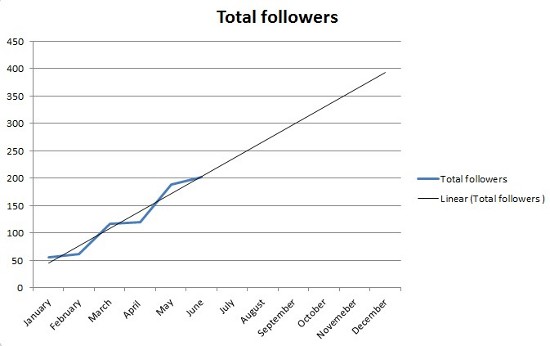
Follow the steps above to make it look the way you want. (If it’s a line, click on the line if bars, click on the bars etc.)ģ.
#Excel trendline of a trendline series#
Right-click on the data series you want to add the trendline for.
#Excel trendline of a trendline how to#
The power trendline is best for distributions where the data is increasing at a certain rate, such as with acceleration.Īlso read: How to Combine Two or More Excel Spreadsheets How to choose: check the R-squared Basically, just tally up the peaks and set the order to that. You’ll have to set the Order to make this work, but that’s pretty easy to figure out: just count the number of bends in the curve by looking at how many times it shifts from moving upward to moving downward or vice versa. In the spreadsheet below, the Excel Trend Function is used to extend a series of x- and y-values that lie on the straight line y 2x + 10. The syntax of the function is: TREND( knownys, knownxs.

Polynomial trendlines are good for data that moves up and down in wave patterns. The function then extends the linear trendline to calculate additional y-values for a further supplied set of new x-values. If something initially increases quickly and then levels out, a logarithmic trendline will probably fit quite well. LogarithmicĪs the inverse of the exponential function, a logarithmic trendline is used for data where the rate of change decreases as the x-values increase. This is best for data where the data is increasing or decreasing exponentially, as the name suggests. If your data’s rate of change increases as the x-values increase, an exponential trendline can help you more accurately visualize what’s happening. If that’s still overfitting, just add more to smooth out the line. The default is two, meaning it will take the average of every two data points.

In the following example, an exponential trendline is used to illustrate the decreasing amount of carbon 14 in an object as it ages. You cannot create an exponential trendline if your data contains zero or negative values. For best results, adjust the periods – the number of data points Excel averages will decide where each point on the trendline will go. An exponential trendline is a curved line that is most useful when data values rise or fall at increasingly higher rates. If you have some rather choppy data, consider using a moving average to help you smooth it out and get a better picture of the general trend. This is best for datasets where the points more or less fall on a straight line. It just shows a line of best fit, or the rate at which something is increasing or decreasing.

You can copy and paste the data into Excel so you can play along. Our example will have Time in years and Stock Value in dollars. Then we can do some neat things with the trendline and see what it means. The first step is to create a scatter plot. The problem is I need this trendline to fit the first part of the data and not the last part. So I have a scatter plot that I need to add a trendline to. Let’s assume you haven’t learned all about Excel yet. Adding a Trendline for Only Part of a Graph. How To Create An Excel Scatter Plot With Linear Regression Trendline Now we know those words are actually English and what they mean. That line is a simple linear regression trendline through a scatter plot.

Could we draw a line through the dots that would show a trend? Let’s call that a trendline.


 0 kommentar(er)
0 kommentar(er)
